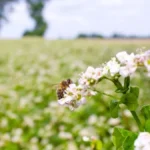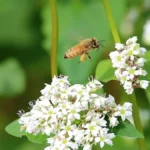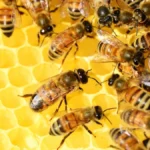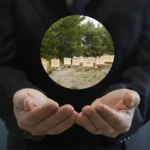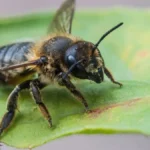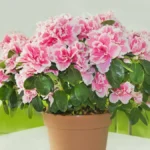The choice between having a wildflower meadow instead of a lawn is an interesting one. In this article, we look at how you can rehabilitate your lawn into a working piece of meadow that produces environmental benefits for you, and your neighborhood.
Where Does The Idea Of A Lawn Come From?
In preindustrial times, rich people had horses and carts. Poor people walked. If you were rich, you had a field around your house for your horses to graze on. This was your fuel tank. A rich person had a big house surrounded by green lawns which fed their transport.
As the gasoline engine transformed the world, it displaced the horse. We all got access to more energy and became richer. Now it was possible for less “rich” people to live far away from cities and commute in their cars each day. With this increased status, people chose to show how rich they were by having a big “fuel tank” around their house.
The lawn has been a terrible waste of resources – now we actually have to use gasoline-powered horses – lawnmowers – to mow our lawns, adding insult to injury. The lawn is actually consuming energy.
The Beekeepers Lawn 2.0
What did we have before lawns? Well, we had an ecosystem. We had forests, we had meadows, we had wetlands and swamps and all sorts of beautiful things that we have turned into a green wasteland.
To turn your lawn into Lawn 2.0 – a wildflower meadow is a rewarding and special endeavor that will bring insects, pollinators, small animals, maybe large animals, fungi, and microbes back into your life.
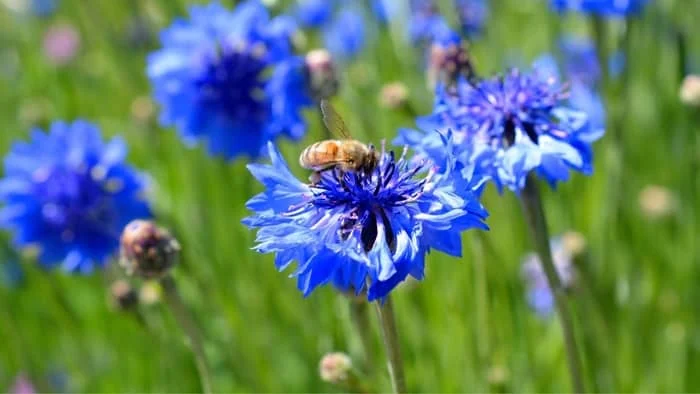
A meadow is basically a grassy, herby mix of plants, many with flowers. It should have a lovely smell to it and have insects buzzing around in it. Nothing better than to grab a recently legalized herbal product, enjoy it and lie on your belly in the meadow and watch stuff going on.
How To Make A Meadow
Genetic Material
There will be seeds in your area that will find their way into your lawn. If you allow a lawn to grow longer it will eventually naturally turn into a meadow. Our objective with any restoration project is however to speed this process up.
If you have an aggressive grass type in your lawn it can help to remove patches of this grass and to find wildflowers in your area, collect seeds and sprinkle these into the lawn.
Exotic/Extralimital Meadow
In many cases, people opt to have an exotic meadow. In this sense, what we are saying is that the species that grow in the meadow are not in fact indigenous to that area. They are instead really just plants from all over the world which have been selected for their pretty flowers and scents and so on. This is an example. I note that most of these mixes are currently not in stock. Hopefully, as the world normalizes post-COVID this will change.

In many cases, exotic plant species can become invasive – in some ways, it may be better to have a lawn if you are near a field or similar place into which these plants can escape and become a pest.
Indigenous Wildflower Meadow
Indigenous plants pose less threat to the environment. In fact, growing indigenous flowers is actually great as you are growing the flowers that the insect pollinators that are indigenous to your area need.
Depending on your area, there are often wildflower meadow mixes that are made from flowers indigenous to your state or region. As an example for Colorado or for the Northeast region of the US.
Ecological Succession
It is important to understand that a meadow is not a stable phenomenon. Nature is fluid. You will put in wildflowers in your meadow. These will attract pollinators and birds. The birds will have been in a forest nearby and some of these birds will poop and drop a seed or two into your meadow.
With time, a meadow can turn into a patch of scrub, and then a forest.
You will have to decide, as the custodian of your patch of our ecosystem, how you will direct this evolution. I have a lovely memory of sitting in a meadow in the middle of Tokyo – the horticulturalists had allowed this meadow to vegetated and had sculpted some of the trees and bushes that grew into elegant bonsais. It was a weird feeling to be in the middle of one of the biggest cities in the world, yet to feel so “lost in nature”.
The process by which an ecosystem migrates towards ever greater levels of complexity is called ecological succession. In terms of managing your meadow, you are the boss and choose how far this succession will go.
Outputs Of Your Meadow
Your meadow will provide nectar to butterflies, indigenous bees, and other pollinators. In this way, you contribute to environmental sustainability. Your meadow will capture carbon – yes, meadows capture more carbon than a lawn. By having a meadow, you help to cycle carbon dioxide out of the atmosphere into the soil.
What does carbon do in the soil? Soil carbon drives nitrogen fixation. Nitrogen is the backbone of the protein that makes up life. As bees pollinate flowers, they consume pollen as food. This food gets digested and pooped out into nature as a magical fertilizer. The more this cycle goes, the healthier your ecosystem becomes.
If you have some bees, the meadow will provide them with a little food too. If you wish you can read this article to find out how to bring wild bees into your garden with a few simple wild bee nesting sites. Wild bees are often solitary and will make their little nests in sticks or in specially constructed nesting sites you can provide.
Wild bees will pollinate berries and fruits in your garden. They are also just amazing to look at.

This is an example of a little wild bee nesting site I made. You can see many of the holes have somebody living in them. The brown holes are mason bees and the white holes may be spiders or possibly small carpenter bees. It is difficult to tell without killing the young.
We hope this has helped you understand how to undo the damage a lawn does to our environment and your pocket and turn it into an asset to you and the planet. I personally think there is nothing cooler than an afternoon spent chilling in the meadow appreciating things. Share if this was on your wavelength.
Learn more about:Protecting Beehives From Bears
Beekeepers Wildflower Meadow FAQs
Why should I consider replacing my lawn with a wildflower meadow?
A wildflower meadow provides ecological benefits like supporting pollinators, improving soil health, reducing water usage, and enhancing biodiversity, making it a more sustainable alternative to traditional lawns.
How do I start turning my lawn into a wildflower meadow?
Begin by removing or reducing aggressive grasses in your lawn, then introduce native wildflower seeds. Let the grass grow longer to allow natural meadow development, or accelerate the process by planting specific wildflower species.
What are the environmental benefits of having a wildflower meadow?
Wildflower meadows support pollinators such as bees and butterflies, improve soil carbon capture, and reduce water consumption compared to traditional lawns. They also contribute to biodiversity by creating a habitat for small animals and insects.
Can a wildflower meadow thrive in any climate?
Yes, wildflower meadows can be established in most climates. However, it is essential to choose wildflower species that are native to your region, as they are more likely to thrive in local soil and weather conditions.
How long does it take for a wildflower meadow to fully develop?
Depending on the method used, a meadow can begin showing signs of establishment in one growing season, but full development might take two to three years as plants mature and ecological succession takes place.
Do wildflower meadows require maintenance?
Yes, but significantly less than a traditional lawn. You may need to mow it once a year in late fall to maintain the balance between grasses and flowers, and occasionally reseed patches to ensure biodiversity.
What is the difference between an indigenous and an exotic wildflower meadow?
An indigenous meadow features native wildflowers that naturally grow in your region, supporting local ecosystems. An exotic meadow uses non-native species selected for aesthetics, but these may not offer the same environmental benefits and could become invasive.
How does a wildflower meadow support pollinators?
Meadows are rich in flowering plants that produce nectar and pollen, which are essential food sources for pollinators such as bees, butterflies, and other insects. This supports pollinator health and biodiversity.
What is ecological succession, and how does it affect my meadow?
Ecological succession refers to the natural progression of an ecosystem. A wildflower meadow might eventually transition into a shrubland or woodland as birds and animals introduce new seeds. You can manage this by periodically clearing larger plants to maintain the meadow.
Can I still enjoy my yard for recreational purposes if I have a wildflower meadow?
Absolutely! Wildflower meadows can be aesthetically pleasing and functional. You can create paths through the meadow for walking, designate areas for seating, and enjoy watching wildlife and pollinators in your own yard.

Dr. Garth A. Cambray is a Canadian/South African entrepreneur and beekeeper with 28 years of experience in apiculture and specializes in adding value to honey. His Ph.D. research developed a new advanced continuous fermentation method for making mead that has resulted in a number of companies globally being able to access markets for mead. His company, Makana Meadery, exports honey mead to the USA where it is available to discerning connoisseurs. He has also developed technologies to commercially manufacture organic honey vinegar in Zambia for export globally. He holds a few patents globally in the ethanol industry and believes in technology and knowledge transfer for human development and environmental sustainability. One of his proudest achievements is the fact that the wind farm he started at one of his old apiary sites has essentially made his hometown carbon neutral.

